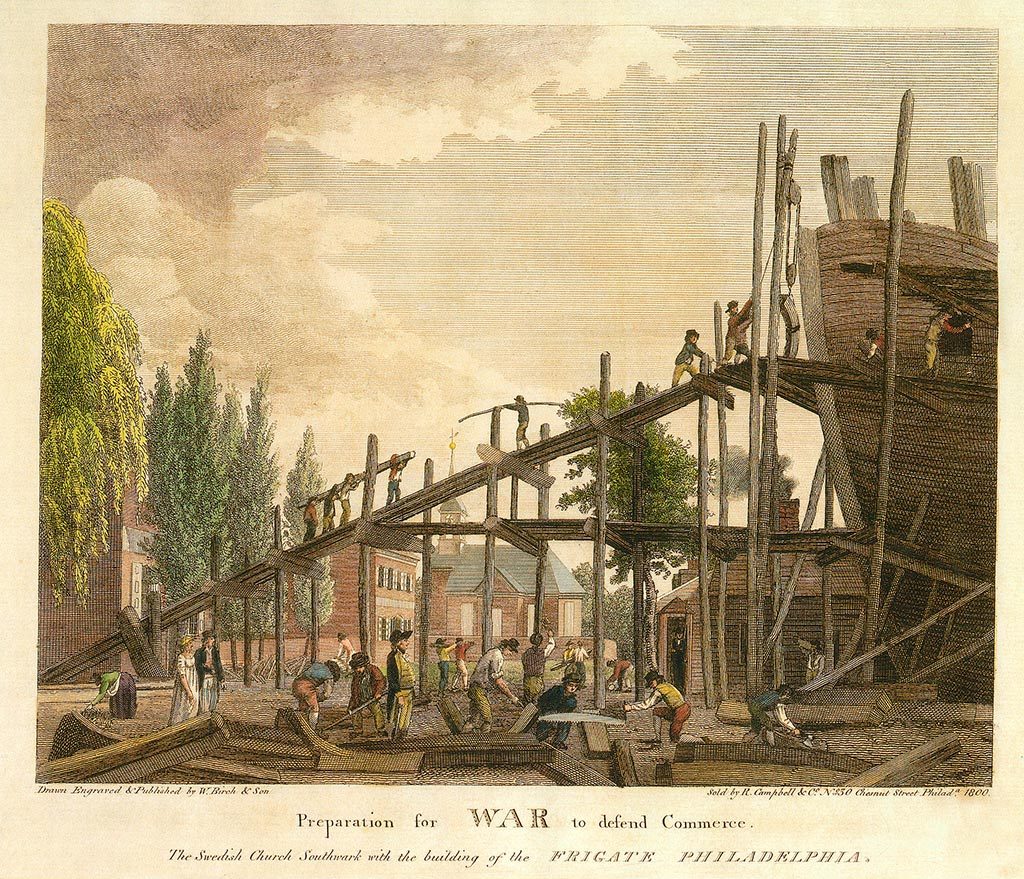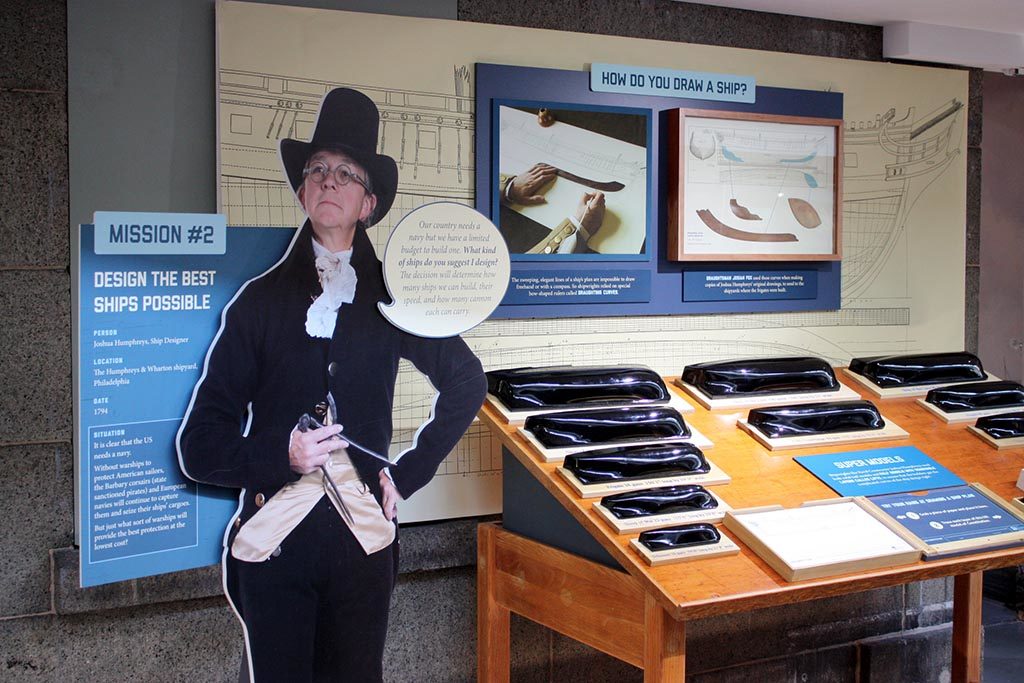From the present appearance of affairs, I believe it is time this country was possessed of a Navy…[Frigates,] I suppose, will be the first object, and…[none] ought to be built less than 150 feet keel…Several questions will arrise, whether will, one [large or] two small Frigates contribute most to the protection [of our] trade…for my part I am decide[dly of opi]nion the large ones will answer best. [Joshua Humphreys to Robert Morris, January 6, 1793]
Joshua Humphreys was born on June 17, 1751, in Haverford, Pennsylvania. He became a ship carpenter’s apprentice and eventually took over his late master’s shipyard. Humphreys was commissioned by the United States government in 1776 to build ships in Philadelphia and prepare them for the Revolutionary War.
In the 1790s, as the new United States merchant fleet sailed far and wide to places such as the Mediterranean Sea, a navy became necessary to protect these American vessels. In 1794 Humphreys convinced the U.S. Congress that a new navy for the country should be comprised of large, heavily built and armed frigates. Humphreys became the principal architect of the U. S. Navy’s original six frigates, and his design aimed for speed, maneuverability, and greater fire power than the European navies of the time.

Bringing Joshua Humphreys’ Story to Life in Forest to Frigate
In June 2016, the USS Constitution Museum opened its newest exhibit, Forest to Frigate, which follows the creation of the U. S. Navy’s fleet from Joshua Humphreys’ design, to the forests in which “Old Ironsides’” timbers grew, to her launch in 1797 as a fully formed frigate. This hands-on, minds-on exhibit allows visitors to explore President George Washington’s decision to create a navy to protect the growing American merchant fleet.


Construction & Launch
Through watercolor and ink sketches, English illustrator Stephen Biesty has brought to life the building and launch of USS Constitution. Visitors to the USS Constitution Museum can see Biesty’s sketches in action in a short film animated by artist and educator Anna Lindemann. The film is titled “Construction & Launch” and is on view as part of Forest to Frigate.



Design Your Warship
“…the vessels should combine such qualities of strength, durability, swiftness of sailing, and force, as to render them equal, if not superior, to any frigates belonging to any of the European Powers.” [Report of the Secretary of War, December 29, 1794]
Speed, maneuverability and heavy firepower were the key elements that made Humphreys’ frigates a superior class. In Forest to Frigate, visitors have the opportunity to employ Humphreys’ theories of warship design to create their own virtual frigate. Visitors can then test their ships against other frigates in a virtual challenge.

Drawing a Warship Across Four Centuries
Humphreys’ original drawing was the two-dimensional lines plan that the naval constructor and shipbuilders used to build Constitution. Using the Sheer, Half-Breadth, and Body plans, the builders shaped the native white oak and live oak timbers to create the hull of the massive 44-gun frigate.

Over the centuries, Constitution‘s lines have been redrawn several times to reflect ongoing changes to her structure. For example, in 1883 an elevation plan was drawn showing the framing of the “barn” built over her spar deck when she was turned into a receiving ship. By the 20th century, new lines plans were drawn for restoration purposes. The 1927-1931 restoration, which involved replacing 85 percent of the ship, necessitated dozens of new plans, including both interior and exterior hull plans, standing and running rigging, and the ship’s sails. Up until the 1992-1996 restoration, all plans were hand-drawn by United States Navy naval architects.
![An elevation of the framing for the barn over USS Constitution in the Portsmouth Naval Shipyard, March 1883. [Courtesy National Archives]](/wp-content/uploads/2016/09/17381-1_resized.jpg)

In the 1992-1996 restoration, naval architects began creating CAD (computer-aided design) drawings for specific sections of the ship. The basis for these drawings were and still are the 1927-1931 restoration plans. James Almeida, Naval Architect Technician for the Naval History & Heritage Command Detachment Boston, is redrawing and documenting the work completed during the 2015-2017 restoration. The advantage of the CAD program is that it allows the architect to take precise measurements from the plan, make design changes, and document the project.


Over four centuries, after Joshua Humphreys drew the first plan for the 44-gun frigates, his superior design and creation is still a marvel today. In Forest to Frigate, through engaging displays and rare artifacts, visitors can meet those who dreamed, designed, and built USS Constitution and explore why she was built and how her superior design and sturdy construction made her the most fabled warship in American history.
_____
The activity that is the subject of this blog article has been financed in part with Federal funds from the National Maritime Heritage Grant program, administered by the National Park Service, U.S. Department of the Interior, through the Massachusetts Historical Commission, Secretary of the Commonwealth William Francis Galvin, Chairman. However, the contents and opinions do not necessarily reflect the views or policies of the Department of the Interior, or the Massachusetts Historical Commission, nor does the mention of trade names or commercial products constitute endorsement or recommendation by the Department of the Interior, or the Massachusetts Historical Commission.
The Author(s)
Margherita Desy, Historian, Naval History and Heritage Command Detachment Boston
Historian, Naval History and Heritage Command
Margherita M. Desy is the Historian for USS Constitution at Naval History and Heritage Command Detachment Boston.
Phaedra Scott
Content Developer, USS Constitution Museum
Phaedra Scott was the Content Developer at the USS Constitution Museum from 2016 to 2017.
Kate Monea
Manager of Curatorial Affairs, USS Constitution Museum
Kate Monea is the Manager of Curatorial Affairs at the USS Constitution Museum.
